
© Dave Morgan. (Click image for larger version)
Royal Ballet
Birthday Offering, A Month in the Country, Les Noces
London, Royal Opera House
30 June 2012
Gallery of 36 pictures by Dave Morgan
Brendan McCarthy on why Nijinska’s Les Noces has stood the test of time (from 2003)
www.roh.org.uk
Lovers of Ashton should make the most of this triple bill at Covent Garden. No work of his is programmed until February 2013, though that does have the compensation of being an all-Ashton evening. This mixed bill illustrates different aspects of his creativity from the pure dance classicism of Birthday Offering, not performed in full by the Royal since 1998, and the exquisitely distilled narrative of A Month in the Country. The evening concludes with Nijinska’s Les Noces, acquired by Ashton for the company in the 1960s in a lovingly-maintained production. It is a fine selection which illustrates the variety of the Royal’s heritage works, which must beg the question how well are they are danced now.
Birthday Offering poses the question in particularly pitiless terms. Ashton made this work to celebrate the 25th anniversary of what was then the Sadler’s Wells Ballet, and to display the strength in depth of the company’s leading female dancers. It offers us seven ballerinas, each with their own variation, and a pas de deux for the leading ballerina and her partner which is full of taxing challenges. The work is set to the music of Glazunov and still uses the original designs from 1956 with elaborate and highly-decorated bell-shaped tutus for the women.
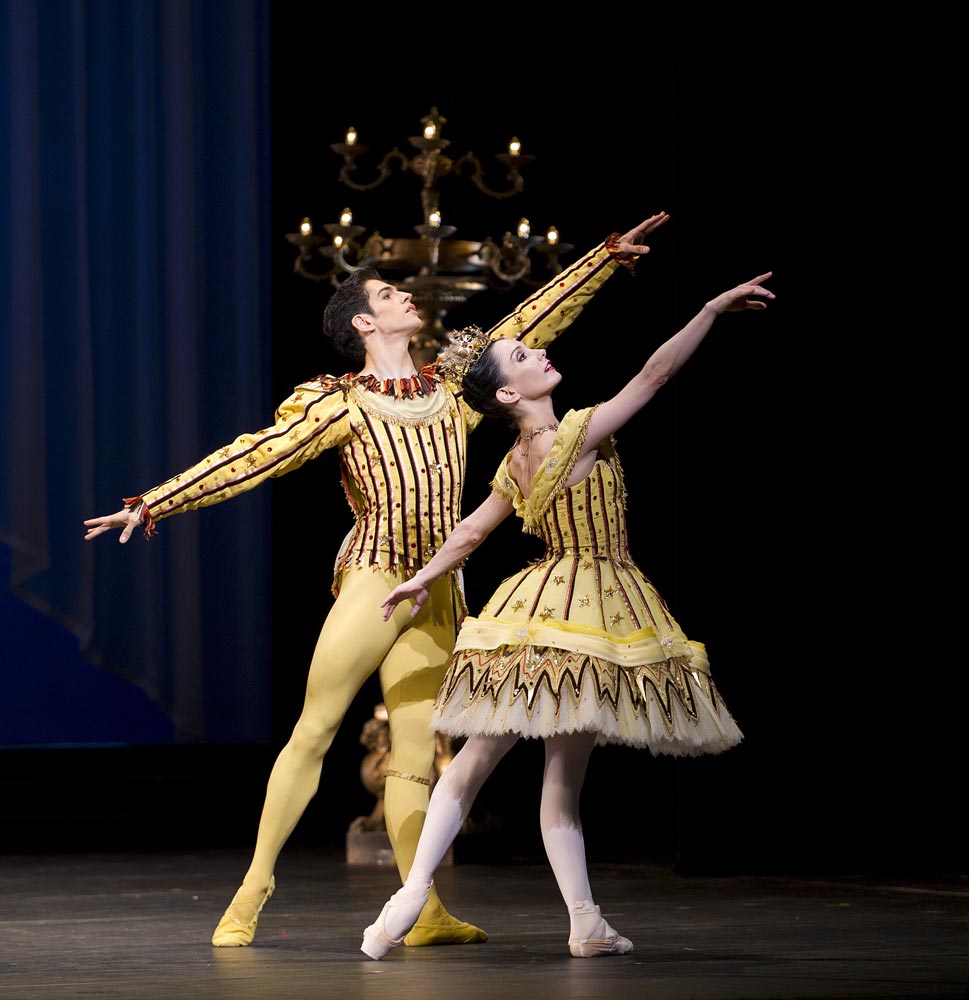
© Tristram Kenton, courtesy of ROH. (Click image for larger version)
It was led at this performance by Tamara Rojo, who has the authority, technical control and glamour required to pull this off. The pas de deux is full of balances which need a telepathic partner to move into the right position at the exact second: Federico Bonelli was supportive and sympathetic. There is one delightful moment where she balances and he pushes one of her hands and she spins like a top, first one way then the other, as if she is some marvellous toy.
It was a more mixed experience for the other six ladies. Choe looked relaxed, undaunted and charming as the first of them in grey. She was followed by Laura Morera in red who looked like she was having a wonderful time, darting about the stage, in control of the rapid changes of direction. She might have been a close relative of the Autumn Fairy from Cinderella. Not all of the rest of them looked quite so at home in the Ashton style, though Sarah Lamb still had a commanding air. An awareness of how difficult the choreography was kept breaking through. Helen Crawford who gave the final solo before Rojo did not look at all happy. (I had flashbacks to Miyako Yoshida doing the Fonteyn solo, like a hummingbird just floating above the stage; that kind of magic was in short supply in this performance.)
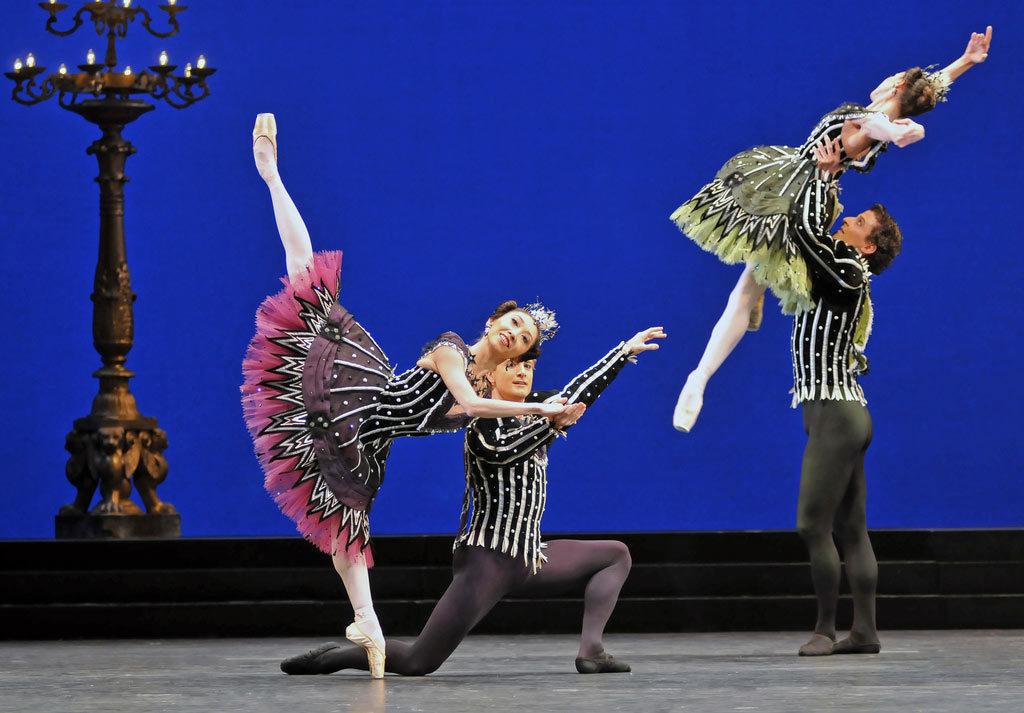
A Month in the Country was much more successful and more warmly received. It is an exceptionally lucid piece of storytelling. In just 44 minutes it gives us fully rounded characters whose motivations we understand. Life on a Russian country estate is profoundly disturbed by the arrival of a handsome young tutor for Natalia Petrovna’s young son: he creates havoc in arousing her feelings, those of her young ward and even the maid, and prompts jealously in her established admirer.
Zenaida Yanowsky returns to the stage in the leading role after a long absence this season, and how good it is to have her back. She is a subtle and thoughtful actress: she never telegraphs her intentions but they come across nevertheless in a little movement of the hand or a turn of the head. As the work opens she is lying on a chaise-longue conducting a master class in semi-bored flirting with Gary Avis as Rakitin, all done in minimal gestures.
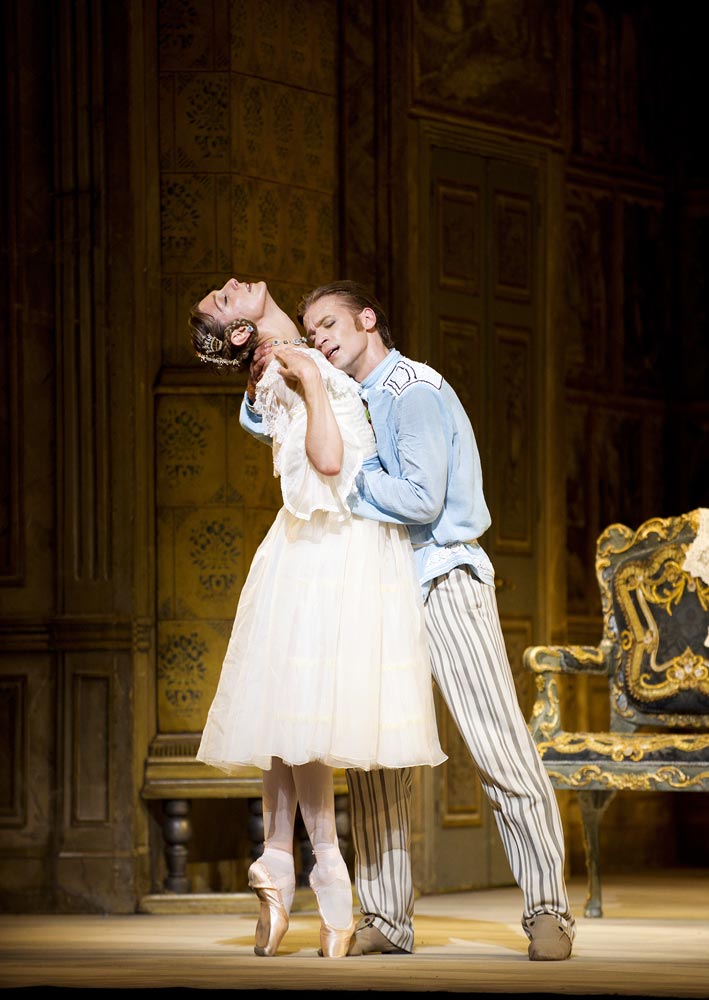
© Tristram Kenton, courtesy of ROH. (Click image for larger version)
Rupert Pennefather is Beliaev, the cause of so much heartbreak. He has been criticised in the past for being somewhat wooden or unresponsive in stage presence, but oddly that works in his favour here. His Beliaev is perhaps not that bright and he really doesn’t have much idea of the impact he is having on Emma Maguire’s hormonal young Vera, or even the maid Katia, but simply accepts their attentions without much thought of the consequences. His dancing is confident and unforced. The entire household except for dear old Yslaev, Natalia’s husband, seems to have flirtation on the brain: even the footman can be seen kissing the maid in the background as she arrives with her cherries.
There is fine dancing from Ondiviela as Kolia, and from Emma Maguire as Vera, her feet fluttering with an erotic charge when lifted by Beliaev. Yanowsky’s back bends luxuriously with passion as she is held by Pennefather: her dancing seems the pure expression of her thought.
At the curtain call it was good to see that the pianist, Kate Shipway receive a bouquet – musicians are not often acknowledged like this at the ballet.
Les Noces gives us a completely different, harsh and brutal take on rural Russia. Whereas the earlier parts of the programme highlighted individuals, this is about the collective of the corps. Nijinska made this in the 1920s to the pounding rhythms of Stravinsky’s score. This is a schematic portrait of a peasant wedding, as an ancient formal rite for the massed ranks of the villagers.
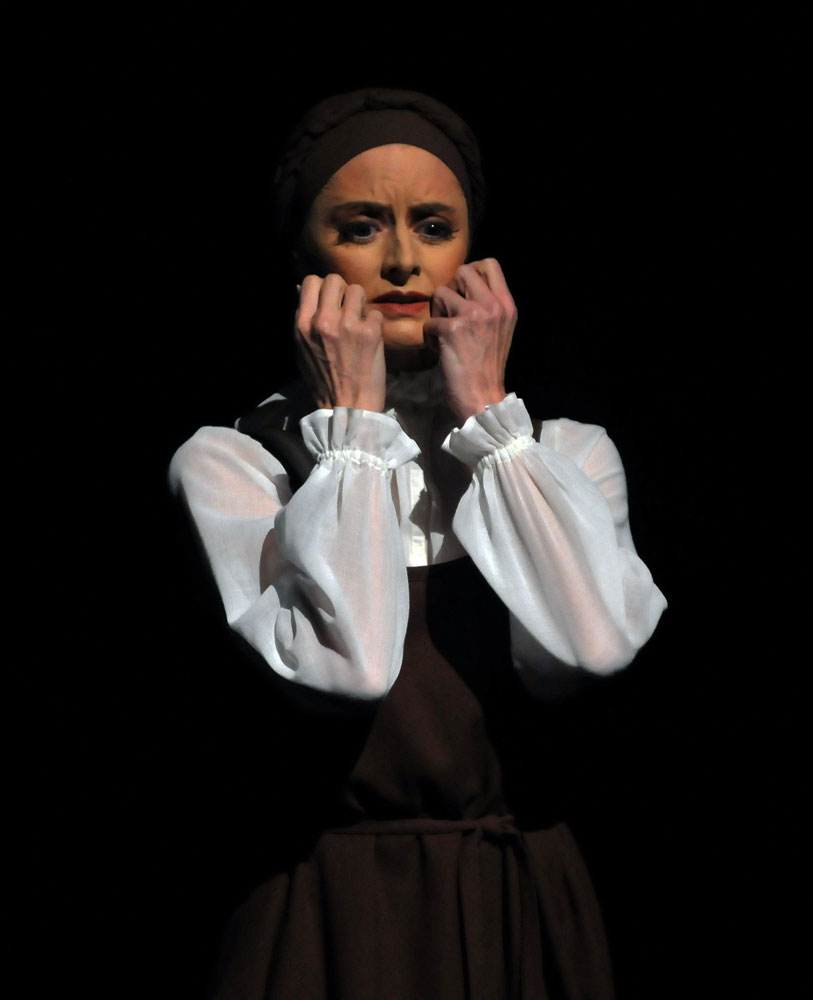
© Dave Morgan. (Click image for larger version)
The palette is deliberately restricted to browns, whites and greys. The bride and bridegroom are impassive: they barely move. It is a solemn occasion, not a happy one: the couple finally enter the wedding chamber at the close as if to a sacrifice. It is a harsh and bleak vision but undeniably thrilling, driven along by the percussive score.
Nijinska piles up the bodies of the villagers in pyramids and masses them in sculptural groupings. The pounding of the pointe shoes is an integral part of the experience. The Royal have always performed this with commitment and a strong collective spirit. A little more unison was required in some of the massed jumping sections earlier in the work: later it came together better, and in future performances in the run should improve still further. Christina Arestis is stoic as the Bride, calm but not quite able to suggest the inner suffering that Yanowsky used to bring to this role. Nevertheless the overall impact is still visceral.
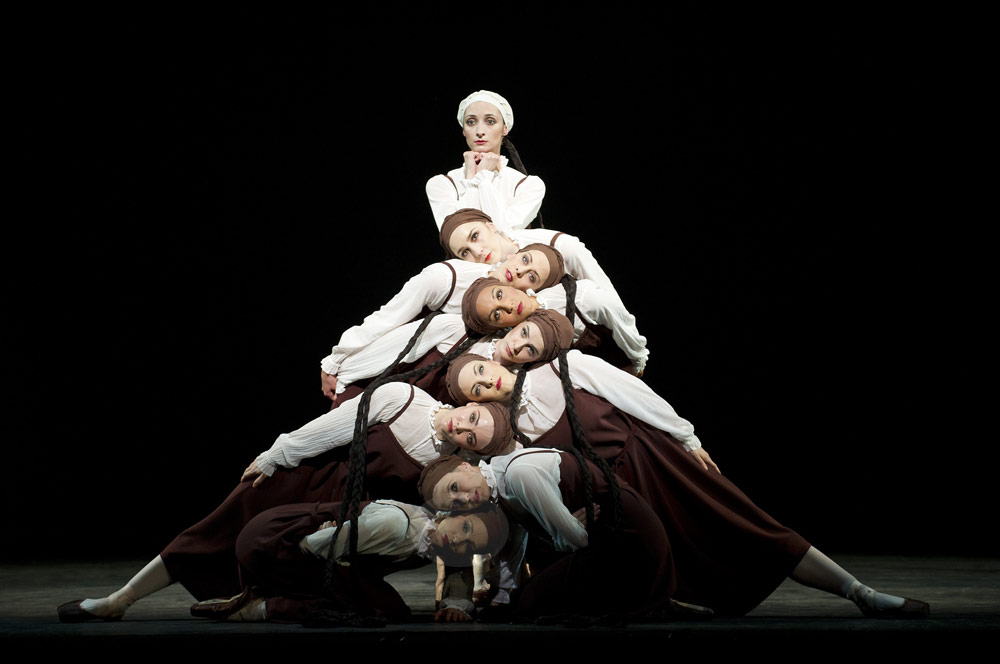
© Tristram Kenton, courtesy of ROH. (Click image for larger version)
Musically this work was the highlight of the evening. The massed forces in the pit include four pianists and four singers, all ushered onto the stage for a curtain call by the conductor Barry Wordsworth, beaming with pride for his troops.












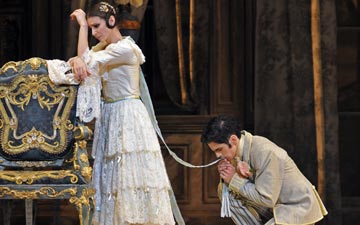
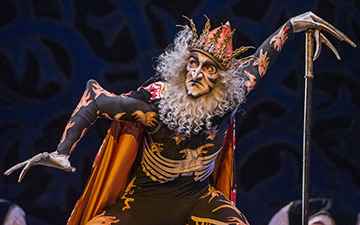
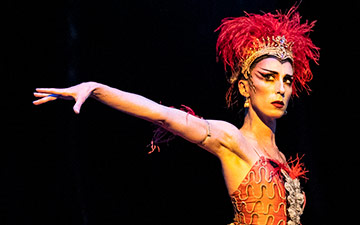
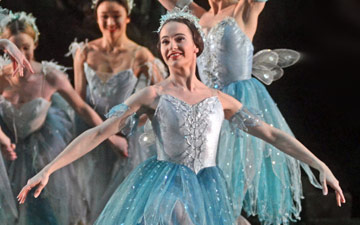

Makes me want to see Month in the Country…
I was there. The Royal Ballet at its best!
Dusty looking on paper, in performance this was a stimulating triple bill.
The music and costumes are lush even if the set suggests a ballroom after a visit from the bailiffs. After a tantalising glimpse of Birthday Offering at the golden jubilee gala a decade ago, when the dancers ducked under a jammed drop cloth, it is a pleasure to see in full the results of Ashton’s private lessons with Petipa.
Who choreographs ballets like this anymore? Bintley and MacMillan did in their various seasons’ ballets. Perhaps Liam Scarlett will. But the classical language so charmingly animated is a lost art.
It doesn’t look a natural language for today’s hyper-extended dancers. I wonder what dancers think of it? Compared to the offerings I saw in the mid-1980s – scaredy girls sent out to do women’s work, these seven brides look up to the job, Laura Morera especially. Only queen bee Tamara Rojo, regal but remote, disappointed. I would prefer a longer limbed dancer in the role, or one with more glint of spontaneity.
The seven brothers (Messrs Bonelli, Campbell, Cervera, Hristov (particularly), Maloney, Stepanek and Whitehead), crisp and precise, gave one hope for the fairy cavaliers in Sleeping Beauty at this address.
Those commentators that criticise this Month in the Country as comedic fail to understand Turgenev’s play – as increasingly I believe did Ashton.
So masterly is Ashton’s concision of a five-act, 3½ play into 40 minutes that you can forgive the schmaltz of his ballet – particularly when in four scenes – Natalia’s duet with her lover Rakitin and the three contrasted duets that the gauche Beliaev dances successively with Vera, Katia and Natalia – palpably demonstrates the expressiveness of human emotion that only dance is capable of portraying.
But surrounding that is Ashton’s misapprehension that A Month in the Country is a tragedy. Although too old for their roles, when Helen Mirren and John Hurt were cast in the play some 20 years ago, there was no doubt that Turgenev’s play is unsentimentally funny, unsparingly mocking the characters’ vanities.
Ashton misrepresents the characters. Instead of up to his knees in mud down at the weir (as Turgenev describes, to Natalia’s distaste) Yslaev here is dapper in a pink bow tie and pink lined coat, hunting for his keys in an enigma variation too many. The prissy, prettified set is too Petersburg grand for a country dacha. The costumes, for upstairs and downstairs characters, in tasteful tones of beige and powder blue, all come from the same store.
Performances suggested the dancers have not read the play. Alone, Emma Maguire as Vera demonstrated she understood Turgenev and Ashton. Excellent.
Natalia is a gift – but a minefield. Zenaida Yanowsky was not as blank as many Natalias (Marguerite Porter, Antoinette Sibley, Darcey Bussell) nor a conscious imitation of Lynn Seymour (Muriel Valtat) but she was inexpressive. The great duet with Beliaev, where Natalia’s real feelings are for once exposed – quiverful, trembling on the edge of orgasm – here failed to arouse.
Rupert Pennefather was Beliaev, a dancer I normally find disengaged from his surroundings. Here he was too consciously aware of his impact. Coiffed like a young Sergei Lifar did not help an impression of coltish innocence. Let us see Johannes Stepanek in this role.
As Rakitin, Gary Avis exuded the nonchalant appeal of Rupert Penry-Jones and established more of a character than Ashton sketched.
This Noces demonstrated what The Royal Ballet is for.
Nijinska’s strangeness and modernity still shock. For the first time since I first saw this ballet 30 years ago, here was a Noces that its choreographer would recognise. Heavy, powerful, rooted in the earth, dancers with their feet dirty.
True, none of the elders or the bridal couple had the force they require. As the bride, Christina Arestis particularly lacked projection – her eyes did not register. Ricardo Cervera as lead peasant had the necessary force and it was the ensemble, particularly the men, that carried the ballet.
But Nijinska’s choreography, rather than the exercise in pyramidal geometry it sometimes appears, emerged here with fierce emotional force. With the benefit of hindsight, much of Soviet realism and MacMillan (his Rite of Spring 40 years later) can be seen in Les Noces – but Nijinska was ahead of the curve, then and now.